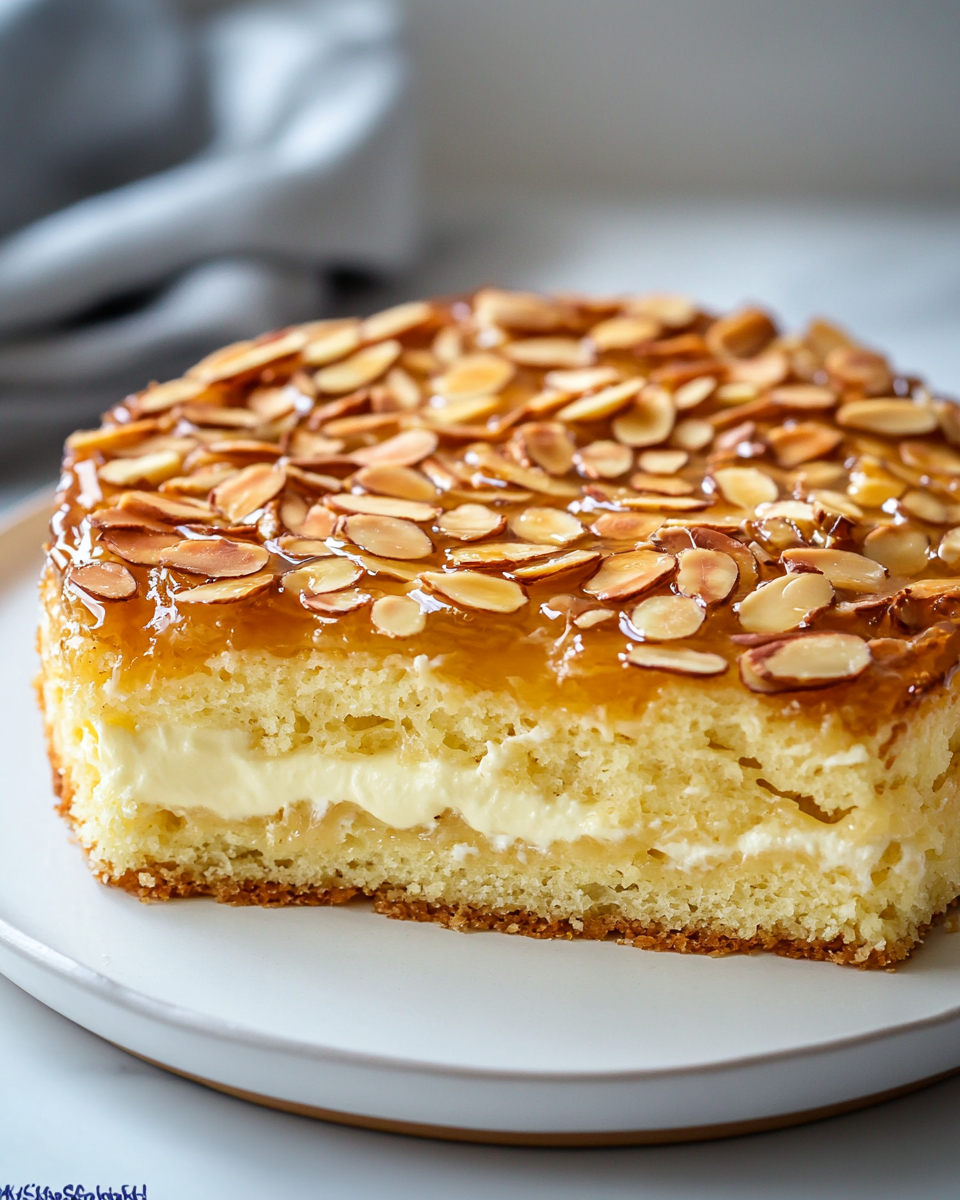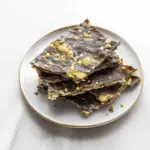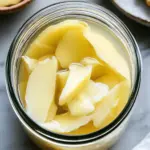The German Bee Sting Cake, or “Bienenstich,” is a classic dessert that blends the rich culinary traditions of Germany with irresistible flavor and texture. Its name comes from the sweet honey almond topping said to be so tempting it could attract bees. With a soft yeast-based cake as the foundation, it’s split and filled with a velvety vanilla custard that offers the perfect creamy contrast. Bienenstich is ideal for afternoon tea, celebratory gatherings, or simply indulging your sweet tooth. The contrast between the crunchy caramelized almond layer and the pillowy interior makes each bite magical. Whether you’re a seasoned baker or trying German desserts for the first time, this showstopper will leave a lasting impression and become a beloved recipe in your collection.
Full Recipe:
Ingredients:
For the Dough:
-
2 1/4 teaspoons active dry yeast
-
1/4 cup warm milk (110°F/45°C)
-
1/4 cup granulated sugar
-
1/4 cup unsalted butter, softened
-
1/2 teaspoon salt
-
1 large egg
-
1 3/4 cups all-purpose flour
For the Topping:
-
1/4 cup unsalted butter
-
1/4 cup granulated sugar
-
2 tablespoons honey
-
1 tablespoon heavy cream
-
1/2 cup sliced almonds
For the Filling:
-
1 1/2 cups whole milk
-
1/4 cup granulated sugar
-
1/4 cup all-purpose flour
-
2 large egg yolks
-
1 teaspoon vanilla extract
-
1/2 cup unsalted butter, softened
Directions:
-
In a small bowl, dissolve the yeast in warm milk and let it sit for 5-10 minutes until frothy.
-
In a large mixing bowl, combine sugar, butter, salt, and egg. Add the yeast mixture and stir in the flour gradually.
-
Knead the dough until smooth and elastic, about 5-7 minutes. Cover and let rise in a warm place until doubled in size, about 1 hour.
-
For the topping, melt butter in a saucepan. Add sugar, honey, and cream. Stir until bubbly. Remove from heat and stir in sliced almonds. Let cool.
-
Preheat oven to 350°F (175°C). Punch down dough and press into a greased 9-inch round cake pan. Spread the almond topping evenly over the dough.
-
Bake for 25–30 minutes until golden brown. Let the cake cool completely in the pan.
-
For the filling, heat milk until just warm. In a separate bowl, whisk sugar, flour, and egg yolks until smooth. Gradually whisk in the warm milk.
-
Return mixture to the saucepan and cook over medium heat, stirring constantly until thickened. Remove from heat and stir in vanilla.
-
Let the custard cool, then beat in the softened butter until creamy and fluffy.
-
Slice the cake horizontally in half. Spread the filling on the bottom layer and carefully replace the top layer. Refrigerate before serving.
Prep Time: 30 minutes | Cooking Time: 30 minutes | Total Time: 2 hours (includes rising & cooling)
Kcal: 390 kcal | Servings: 8 servings
More Than Just a Cake
German Bee Sting Cake, known in its native language as Bienenstich, is one of the most beloved and iconic desserts in traditional German baking. With its name sparking curiosity and its flavor delivering nostalgic joy, this cake has charmed its way into bakeries and homes around the world. The Bienenstich is celebrated not only for its taste but also for its unique texture, elegant simplicity, and the story behind its intriguing name.
Unlike many cakes that rely solely on sweetness or decoration to make an impression, Bienenstich is a harmonious blend of flavors and sensations. It combines a soft, yeast-leavened dough with a luscious vanilla custard filling, topped with a caramelized layer of honey and sliced almonds that offers a light crunch. The contrast between the pillowy cake layers and the creamy, rich filling elevates it into a category of its own.
The Origin of the Name: Why Is It Called “Bee Sting Cake”?
The name Bee Sting Cake has sparked much folklore and historical speculation. One popular legend suggests that during the 15th century, German bakers successfully defended their village from invaders by throwing beehives at them. In celebration, they created a cake made with honey and named it in honor of the bees. While it’s difficult to confirm the accuracy of this tale, the imagery it evokes has helped cement the cake’s charming reputation.
Another theory posits that the cake’s name comes from the honey topping itself, which might attract bees due to its sugary aroma. The “sting” in the name is metaphorical, referencing the sweet “bite” of the almond topping infused with honey. No matter the origin, the whimsical name adds character to an already delightful dessert.
Cultural Significance in German Cuisine
Bienenstich is a staple in German bakeries, especially popular in Bavaria and throughout southern Germany. It is often served at family gatherings, birthdays, and Kaffee und Kuchen (coffee and cake) time a cherished daily tradition in German-speaking countries, where families and friends gather in the afternoon to share coffee and baked goods.
Its long-standing presence in Germany also means there are many regional variations. Some versions are square rather than round, others use whipped cream in place of the custard filling, and still others substitute the yeast dough for a sponge cake base. Despite these variations, the core concept remains: honey-almond topping, soft base, and a creamy middle layer.
A Perfect Marriage of Textures and Flavors
One of the reasons Bienenstich has remained a favorite across generations is its masterful balance of textures. The yeasted cake base is soft and slightly chewy, offering substance without heaviness. This makes it stand apart from more conventional sponge or butter cakes.
The topping is where the magic begins. A bubbling blend of butter, sugar, honey, and cream is poured over the dough before baking. As it cooks, this mixture seeps into the top layer of the cake and hardens slightly into a sweet, crisp, nutty crust. The sliced almonds toast in the oven, deepening their flavor and adding the perfect contrast to the tender interior.
The real surprise lies in the middle: the filling. Traditionally, Bienenstich is filled with a rich vanilla custard or pastry cream. This creamy element not only enhances the flavor but also introduces a luxurious mouthfeel that complements the almond topping and cake base.
Baking Techniques That Make Bienenstich Unique
What truly differentiates Bee Sting Cake from many other European cakes is its foundation: a yeast dough. While yeast is commonly used in breads and pastries, it’s less typical in sweet cakes. This process requires patience proofing and rising times are essential but it rewards the baker with a depth of flavor and texture that is unmatched by chemical leaveners alone.
The almond topping, too, requires a watchful eye. It must be heated just enough to bubble and coat the cake, but not too much or it will over-harden or burn. Mastering this balance is a point of pride for many bakers.
The filling also allows for creativity. While vanilla custard is the traditional choice, some modern bakers incorporate whipped cream, mascarpone, or even flavored pastry creams like coffee or chocolate. These variations reflect the adaptability of the recipe, allowing it to be both timeless and trendy.
Serving and Presentation Tips
Bienenstich is best enjoyed slightly chilled or at room temperature. Its flavor deepens after it rests, making it a fantastic make-ahead dessert. It is often dusted lightly with powdered sugar for a simple, elegant finish.
When serving, it’s important to use a sharp knife to slice cleanly through the almond topping without crushing the delicate filling underneath. Pairing it with coffee or tea brings out the richness of the cream and the subtle sweetness of the honey topping.
Presentation can vary from rustic, homey styles in cast iron pans to clean, modern slices arranged with fresh berries or mint. It holds its own both as a casual afternoon treat and as a centerpiece dessert for holidays or formal occasions.
Variations and Modern Takes on Bienenstich
Though the classic recipe remains untouched in many households, Bienenstich has inspired several variations:
-
Mini Bienenstich Tarts: These are made in muffin tins and offer individual portions.
-
Bienenstich Cupcakes: A fun, contemporary twist that incorporates all the traditional elements into cupcake form.
-
Vegan or Dairy-Free Versions: Using plant-based butter and cream substitutes, it’s easy to make Bienenstich accessible for different dietary needs.
-
Fruit-Enhanced Fillings: Adding berries or citrus zest to the custard filling for a fresh twist.
Each version keeps the spirit of the original while introducing new layers of flavor and creativity.
Why You Should Bake Bienenstich at Home
While it’s easy to find Bienenstich in German bakeries, making it at home is a deeply satisfying experience. From the scent of the yeast dough rising to the aroma of honey and almonds caramelizing in the oven, the process is as comforting as the final result.
Homemade Bienenstich also allows for customization you control the sweetness, texture, and flavors. Plus, serving a cake with such a rich story and heritage is bound to impress friends and family.
Baking this cake connects you to a centuries-old tradition of European home baking. It’s an invitation to slow down, savor, and share something truly special.
Conclusion:
German Bee Sting Cake is more than just a dessert it’s a symbol of tradition, craftsmanship, and joy. With its satisfying combination of textures, nuanced flavors, and historical charm, Bienenstich continues to win hearts beyond its German roots. Whether you’re an experienced baker or someone looking to explore the world of international cuisine, this cake is worth your time and attention.






